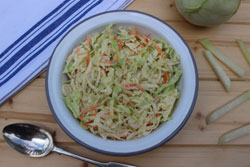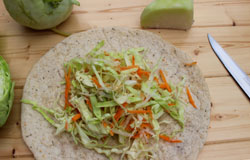Have you ever eaten kohlrabi? Maybe you’ve seen it on country market stalls, or in a vegetable box? It’s not available in supermarkets very often. Or maybe you’ve grown it on your plot: and then wondered what to do with it?

A bit like celeriac, it’s the oddest looking vegetable, like some kind of extra-terrestrial or a sputnik (the first Russian un-manned satellite, launched in the late fifties).
Not so well known here, it’s a member of the brassica family and popular in Germany. Its German name of kohlrabi translates into cabbage turnip.
It has a delicious and intriguing flavour: crisp and refreshing raw it tastes something like sweet spring cabbage crossed with a hint of apple. The flavour changes to soft and comforting when it’s cooked, potato-y with warm and nutty cauliflower overtones. Purple and green varieties are available: they taste virtually the same, purple may be fractionally sweeter.
To prepare: wash, remove leaves and rooty bottom (whole fresh leaves can be steamed like cabbage) and peel.
Grate or cut into matchsticks for salads and crudities or slice for cooked dishes. Halve or quarter larger globes first if necessary.
The cut surface can oxidise slightly so have a lemon handy for squeezing over. I could only get hold of green kohlrabi for the following recipes but purple – or a mixture – would work just as well.
Kohlrabi Salad Mix for Wraps and Quick and Easy Remoulade
This adds a wonderful extra flavour dimension to wraps: pile onto floury tortillas with shredded roast or grilled chicken or grilled halloumi. Season with chilli sauce, lemon juice, balsamic drizzle, a garlicky yoghurt sauce, or whatever you fancy.

Basic Mix
Serves 4
- Half a summer cabbage (such as sweetheart, hispi or greyhound), finely shredded
- 1 medium carrot, grated
- 100-200g kohlrabi, prepared as above, grated and tossed in lemon juice
- 2-3 spring onions, finely sliced
Toss everything together until fully combined.
Quick and Easy Remoulade
Combine 2-3 heaped tablespoons of mayonnaise with a dessertspoonful of low-fat Greek yoghurt, 1 tablespoon cider vinegar, a generous teaspoon of Dijon mustard and a good grinding of black pepper.
Toss with the kohlrabi mix.
Tip
Just before serving add some chunks of tart dessert apple such as Cox’s or Braeburn, tossed in lemon juice.
Kohlrabi and Potatoes in Cream
Luxuriously comforting, this brings out Kohlrabi’s mellow side. Fabulous as a side dish with steak or as a light snack with crusty bread.
Serves 2 but easy to increase quantities proportionally.
- 1 small onion finely diced
- Scant tablespoon oil
- Large knob garlic butter
- 200g kohlrabi, prepared as above
- 1-2 tablespoons lemon juice
- 200g peeled or scrubbed potatoes
- Freshly ground black pepper
- Sea salt flakes to taste
- 150ml double cream
- A couple of small sprigs of thyme
Gently fry onions in oil until soft and just tinged golden
Use some of the butter to grease a small 2 person baking dish.
Slice kohlrabi thinly and squeeze lemon juice over.
Slice potatoes thinly.
Layer kohlrabi and potatoes in dish, spread with half onions and season with salt and pepper. Scatter over a few thyme leaves stripped from stem.
Repeat and finish with layer of kohlrabi and potato. Pour cream over and dot with garlic butter.

Bake, covered in foil, for around an hour or until soft. Remove foil and bake for a further 10 minutes until golden and bubbling.
Serve warm, garnished with extra thyme.
Growing and Harvesting Kohlrabi
Well worth growing in the garden: it’s a bit of a novelty and an easy crop. Available to grow from seed in both purple and green.
For best results harvest between golf ball and tennis ball size, any bigger and they can develop a woody layer that’s hard to peel.
Generally kohlrabi takes 3½ -4 months from seed to harvest, around 15-16 weeks
Make sure the ground is evenly moist right up to harvesting.
To harvest, take hold of the the swollen stem (One plant will give you one kohlrabi) and gently pull the roots from the ground.
To prepare Kohlrabi for eating fresh or steaming cut the leaves off. The leaves are edible: prepare and cook as you would kale.
Top and tail and peel the swollen stem.
Eat as soon as possible after pulling.